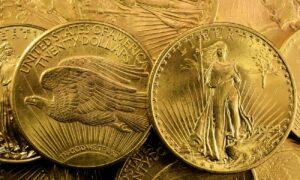Fifteen gold coins dating from the Iron Age have been unearthed by a trio of metal detectorists in Wales, UK, representing the country’s first-ever treasure find of its kind.
Mr. Roberts, who has been hunting for historical artifacts for 14 years, unearthed the first two buried coins in the field. He said finding a gold stater was “always number one” on his wish list.
“Having never expected to actually find one, let alone in Anglesey, can you imagine my shock, delight, and surprise as I called out to my friend Peter, having dug up a beautiful full gold stater in mint condition?!” he said in the press release. “That one coin alone would have made my year, but I went on to find another on my next signal, and then Peter found a total of three.”

The pair sat down to drink coffee and imagined what the surroundings and people’s lives were like over 2,000 years ago.
After Mr. Watson, who is “relatively new” to metal detecting, dug up a further 10 staters over the course of several weeks, the trio declared their find and were “delighted” to discover that theirs was the first collection of Iron Age gold currency ever unearthed in Wales.
Mr. Watson had rushed home to show his wife after finding his first gold coin. He said: “We were both in awe of this coin, which was like nothing else I had found, immaculately preserved with such unusual stylized images.”
The press release said the coins are believed to have been struck between 60 B.C. and 20 B.C., originated from three different mints across the area now known as Lincolnshire, and have been linked to the Iron Age Corieltavi tribe of the East Midlands. Their design is based upon the Macedonian gold coins of Phillip II, depicting the bust of Apollo on the head side, and a two-horsed chariot and rider on the reverse.

Sean Derby of Gwynedd Archaeological Trust, who inspected the site of the find in September 2021, said: “This hoard is a fantastic example of the rich archaeological landscape that exists in North-West Wales. While the immediate vicinity of the find did not yield any clues as to the find’s origin, the findspot lies in an area of known prehistoric and early Roman activity, and helps increase our understanding of this region.”
The 15 staters were likely used as gifts to secure alliances, or to buy copper from Anglesey’s Great Orme, as opposed to being used for everyday transactions, the National Museum of Wales reported. They could also have been used as offerings to the gods since Anglesey was an “important religious center” from the first century B.C. to the first century A.D.
The Oriel Môn museum in Anglesey is interested in acquiring the Iron Age coins to place them on public display.
Ian Jones, Oriel Môn’s building and collections manager, said: “This local discovery is thrilling news for Oriel Môn. The coins are of national importance.”







